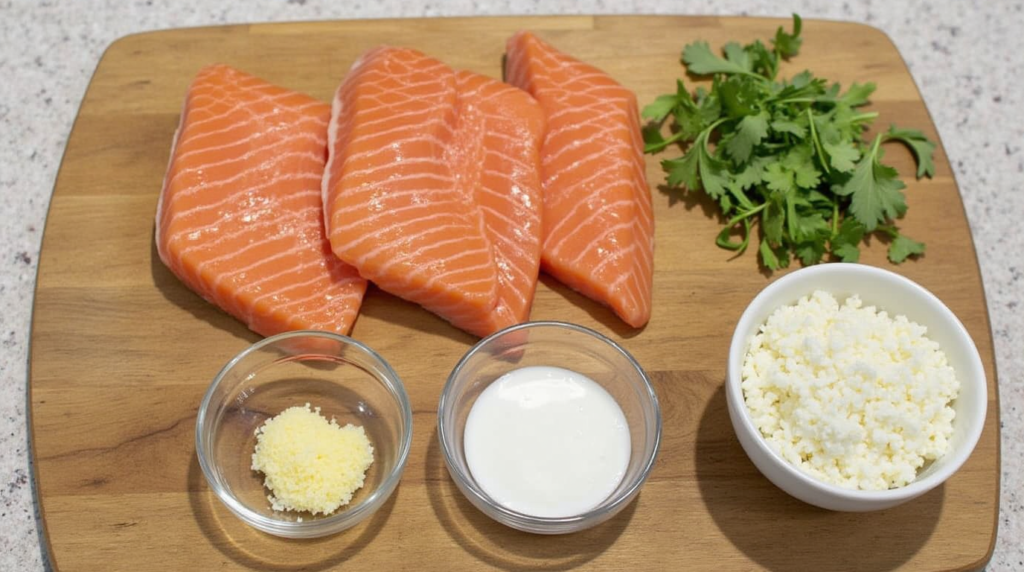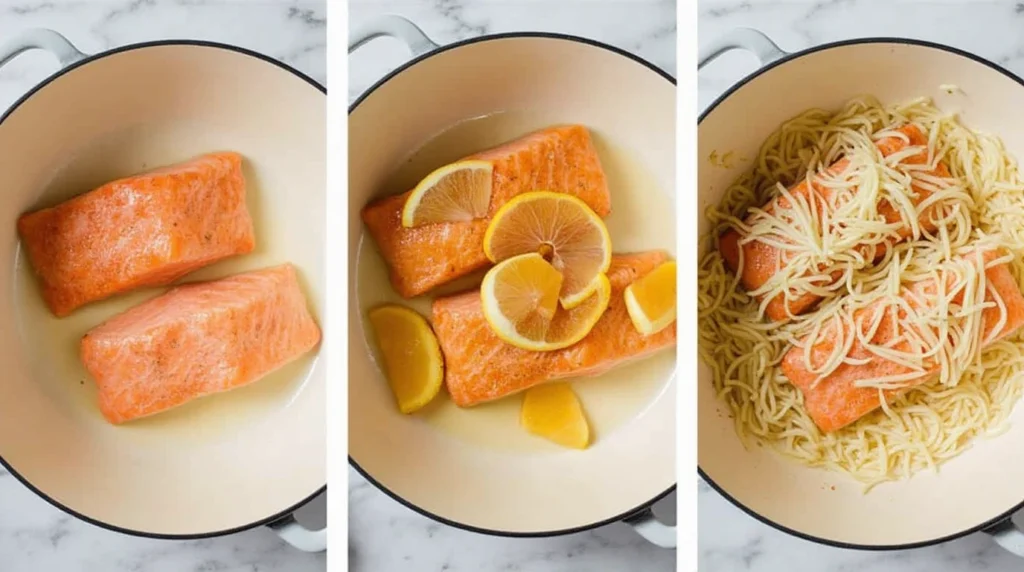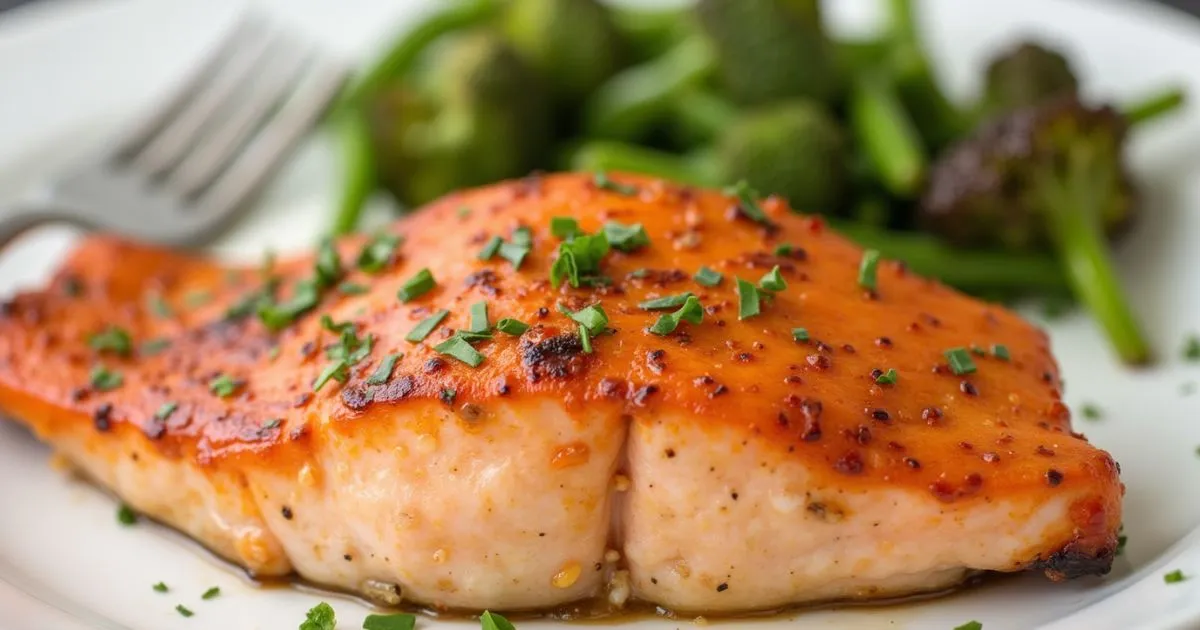Easy Salmon Steak Recipe for Beginners
Table of Contents
Cooking salmon steaks is easy and fun. This recipe uses simple steps and few ingredients, great for kitchen newbies. Salmon steaks are tasty and soft, making them easy to cook, even if you’ve never cooked fish before.
This guide will show you how to cook salmon steaks perfectly. You’ll learn why they’re good for you—they’re full of omega-3s and protein. These nutrients help your heart and muscles. You can grill, bake, or pan-fry them, and they’ll taste like they came from a restaurant.
Key Takeaways
- Salmon steak recipe requires basic kitchen tools like a skillet or baking sheet.
- Steaks retain moisture better than thinner fillets, reducing overcooking risks.
- Seasoning options are versatile, from lemon-pepper to herb blends.
- Health benefits include omega-3 fatty acids and high-quality protein.
- Follow timing guides to ensure flaky, perfectly cooked results every time.
What Are Salmon Steaks and Why Choose Them
Salmon fish steak is a big piece of fish that includes the backbone and meat from both sides. It’s thicker than fillets and has a bolder flavor. This makes it a great choice for a hearty meal.
Difference Between Salmon Steaks and Fillets
- Salmon steaks have a central bone and thicker meat, perfect for grilling or pan-searing.
- Fillets are boneless slices from one side, great for lighter dishes.
- Steaks can handle high heat better, while fillets cook faster.
Nutritional Benefits of Salmon Steaks
Salmon fish steak is packed with 25-30g of protein and lots of omega-3 fatty acids. These help your heart and brain. The thicker cut also keeps vitamins B12 and D in during cooking.
Best Salmon Varieties for Steaks
| Variety | Flavor Profile | Fat Content | Price Range |
|---|---|---|---|
| King (Chinook) | Rich, buttery | High | $$ |
| Sockeye | Deep red flesh, smoky | Moderate | $$ |
| Coho | Crisp texture, mild | Medium | $ |
| Atlantic | Delicate, sweet | Low | $ |
Essential Ingredients for a Perfect Salmon Steak Recipe
The salmon steak recipe needs a few key ingredients to bring out the fish’s natural taste. Each part works together to balance flavors and texture. This makes every bite stand out. Using fresh, high-quality items like olive oil and herbs is crucial.
- Salmon steaks: Choose wild-caught Alaskan salmon or sustainable farmed options. They should have firm, bright flesh.
- Salt and black pepper: These enhance the salmon’s flavor without overwhelming it. Sprinkle lightly before cooking.
- Extra-virgin olive oil
- Fresh lemon: Squeeze it over the cooked salmon to add brightness and cut through fattiness.
- Herbs: Fresh dill or thyme add aromatic depth. Use 1 tablespoon chopped herbs per steak.
- Garlic: Mince 1-2 cloves for a subtle aroma.
Optional extras like capers, Dijon mustard, or honey let you customize your salmon steak recipe. If fresh herbs aren’t available, use dried ones. But, fresh herbs give the best flavor.
Quality is key. Even small details, like using good oil or a zesty lemon, make a big difference. Start with the basics, then try new things once you’re more comfortable.
Kitchen Tools You’ll Need to Prepare Salmon Steaks
Mastering the salmon steak recipe starts with the right tools. Even with basic tools, you can make food that tastes like it’s from a restaurant. Here’s what you need before you start:
Basic Essentials Every Beginner Should Have
- Skillet: A cast iron pan (like Lodge) or non-stick skillet ensures even heat. Cast iron is great for searing, while non-stick prevents sticking.
- Spatula: A wide, flexible spatula (e.g., OXO Good Grips) lifts the steak without tearing. Look for a head at least 6 inches wide.
- Sharp knife: A chef’s knife (8–10 inches) cuts through pin bones smoothly. A dull blade risks breaking delicate flesh.
- Instant-read thermometer: A digital probe (like ThermoPro TP03) confirms doneness at 145°F without overcooking.
Optional Tools That Make Cooking Easier
These items make cooking easier but aren’t required:
- Fish tweezers: OXO’s ergonomic tweezers grip slippery skin easily, ideal for flipping.
- Fish spatula: A thin, flexible edge (as seen in Tongs brand) slides under steaks without tearing.
- Silicone brush: Weber’s silicone brush avoids burning compared to wooden brushes.
- Parchment paper: Lines pans for effortless cleanup, especially when baking.
Start with the basics first. Over time, add optional tools that make your salmon steak recipe routine easier. Focus on function over fancy gadgets—quality basics make all the difference.
How to Select Fresh Salmon Steaks at the Store
Choosing the right salmon fish steak is key. Here are some tips to help you pick quality fish. It should be safe, delicious, and good for the planet.
Visual Cues for Freshness
Look for salmon fish steak with shiny, bright pink or orange flesh. It should feel firm and spring back when touched. Stay away from any with dry edges or a grayish tint.
Check the eyes (if attached) – they should be clear, not cloudy. A mild ocean scent is normal. But a strong fishy odor means it’s not fresh.
When to Choose Frozen Salmon Steaks
Frozen salmon fish steak can be fresher than “fresh” options if you’re inland. Choose vacuum-sealed packs to avoid freezer burn. Thaw it safely in the fridge overnight or under cold running water for 30 minutes.
Look for brands like Costco or Trader Joe’s for high-quality frozen options.
Sustainable Salmon Buying Guide
Choose salmon with MSC or ASC labels for sustainable choices. Wild-caught salmon often has less environmental impact. But farmed options with certifications ensure ethical standards.
As the Marine Stewardship Council says, “Certified seafood means your choice supports healthy oceans.”
Simple Preparation Steps Before Cooking
Before you start roasting salmon steaks, proper preparation is key. Follow these steps for juicy, evenly cooked results every time.
- Bring to room temperature: Let your salmon steaks rest at room temperature for 15-20 minutes. This prevents uneven cooking when you begin roasting.
- Rinse and dry: Gently rinse the steaks under cold water, then pat them dry with paper towels. Moisture left behind can ruin the crispy skin in roasted dishes.
- Check for bones: Use tweezers to remove any pin bones. Run your finger along the flesh—pull out any remaining bones you feel.
- Season strategically: Lightly salt the skin side just before cooking. Adding salt too early pulls moisture, leading to a soggy texture.
- Score the skin: Make shallow cuts (¼ inch deep) across the skin with a sharp knife. This stops curling during how to roast salmon steaks and ensures even heat distribution.
A pro tip from culinary experts: “Dryness is key—moisture’s the enemy of a golden crust,” says Chef Maria Gonzalez of FreshCatch Kitchen. These steps take 10 minutes but make all the difference. Skip them, and your roasted salmon might end up dry or underdone. Now you’re ready to move on to the cooking methods in the next section.
The Best Salmon Steak Recipe for Beginners
Learning to make a salmon steak recipe is easy. This guide will help you make your first dish a hit. Follow these steps for tender, tasty salmon.
Ingredients List

For 2-4 servings, you’ll need:
- 2 salmon steaks (6–8 oz each) – wild Alaskan or farmed Atlantic work well
- 1 tbsp olive oil (or avocado oil for higher smoke point)
- 1 tsp sea salt (or flaked Maldon salt)
- ½ tsp black pepper
- Zest of 1 lemon + 2 tbsp juice
- 2 garlic cloves (minced or sliced)
- ¼ cup chopped fresh herbs (dill, parsley, or chives)
Try paprika or cayenne for spice. Lime juice is a great lemon substitute.
Step-by-Step Cooking Instructions

- Prep: Dry the steaks with paper towels. Rub both sides with oil, then season with salt and pepper.
- Sear: Heat a non-stick skillet over medium-high. Add garlic and cook 1 minute. Place steaks skin-side down. Cook 4-5 minutes without moving.
- Flip: Turn the steaks gently with a spatula. Drizzle lemon juice over top and add herbs. Cook 3-4 more minutes.
- Rest: Let sit 5 minutes before serving to lock in juices.
Timing and Temperature Guide
For moist flesh, aim for 125°F (52°C). For fully opaque flakes, aim for 140°F (60°C). Look for:
- Flesh that flakes easily with a fork
- Translucent center fading to opaque (slightly undercooked is preferred)
“Always check temperature in thickest part – avoid touching bone if present,” says Chef Emily Chen, a seafood cooking instructor.
Adjust cooking time by 1–2 minutes per side for thicker cuts. Overcooked salmon is dry. It’s better to undercook slightly and finish under a broiler if needed.
How to Roast Salmon Steaks in the Oven
Learn how to make a baked salmon steak that’s tender and flavorful. The salmon steak oven method cooks evenly with little effort. Follow these steps for perfectly roasted salmon every time.
Perfect Temperature Settings
Preheat your oven to 425°F (218°C). Place salmon on a parchment-lined baking sheet. Cook for 10-15 minutes, until it reaches 145°F (63°C) inside. Here’s how:
- Preheat oven to 425°F (218°C).
- Place salmon on parchment paper for easy cleanup.
- Bake until opaque and flakes easily with a fork.
Seasoning Ideas for Baked Salmon Steak
Make your baked salmon steak taste amazing with these simple seasonings:
- Herb Crust: Mix dried dill, parsley, garlic powder, and olive oil. Press onto salmon before baking.
- Citrus-Garlic: Squeeze lemon juice, sprinkle minced garlic, and top with cracked black pepper.
| Seasoning | Ingredients | Application |
|---|---|---|
| Honey-Dijon Glaze | Honey, Dijon mustard, soy sauce | Brush on in the last 5 minutes of baking. |
| Soy-Ginger | Soy sauce, fresh ginger, sesame oil | Marinate 10 minutes before roasting. |
Tip: Let salmon rest 5 minutes after baking to lock in juices.
Try these methods with your favorite sides for a quick dinner. Adjust seasonings to taste and enjoy consistent results every time.
Pan-Searing Techniques for Crispy Salmon Steaks
Mastering the pan-sear is key to getting a golden, crispy crust on your salmon fish steak. Use a heavy skillet, like cast iron or stainless steel, to keep the heat even.
- Heat the pan over medium-high until water drops sizzle instantly.
- Lightly coat the pan with oil like avocado or peanut, which smoke points are high.
- Pat the salmon dry with paper towels for even browning.
- Put the salmon skin-side down in the pan first, cooking undisturbed for 3-4 minutes.
- Flip gently once the skin releases easily—this avoids tearing.
- Cook the second side for 2-3 minutes, adjusting heat if edges brown too fast.
| Steak Thickness | Cook Time (Skin Side) | Cook Time (Flesh Side) |
|---|---|---|
| ¾-inch | 3 minutes | 2 minutes |
| 1-inch | 4 minutes | 2.5 minutes |
If the skin sticks, slide a spatula under it gently. For extra crispiness, broil the salmon for 1-2 minutes after flipping. Always check doneness by flaking the thickest part with a fork—it should be opaque but still moist.
- Use a splatter screen if oil flicks.
- Avoid overcrowding the pan to prevent steaming instead of searing.
Perfectly seared salmon fish steak balances technique with timing, yielding a meal that’s both impressive and approachable for home cooks.
Delicious Marinades and Seasoning Combinations
Make your salmon steak recipe stand out with these tasty marinades. Whether you want something simple or bold, the right seasonings enhance the flavor without overpowering the fish.
Classic Flavor Profiles
Start with classic blends that highlight salmon’s richness:
- Lemon-Dill Butter: Mix softened butter with fresh dill, lemon zest, and pepper for a light, herb-forward finish.
- Garlic-Herb: Blend minced garlic, rosemary, thyme, olive oil, and salt. Rub into the steak 15 minutes before cooking.
- Maple-Dijon: Combine maple syrup, Dijon mustard, soy sauce, and a pinch of smoked paprika for a sweet-savory glaze.
International Inspired Seasonings
Global flavors bring excitement to your salmon steak recipe:
- Mediterranean: Olive oil, capers, kalamata olives, and lemon juice mimic coastal Greek dishes.
- Asian Fusion: Ginger, soy sauce, sesame oil, and a dash of rice vinegar mirror Asian cooking traditions.
- Cajun: Blend paprika, cayenne, garlic powder, and onion powder for a spicy kick.
- Nordic Twist: Mix dill, aquavit (or vodka), and mustard for a Scandinavian-inspired tang.
“Seasoning is like a dance—let the salmon’s flavor lead.”
Quick Marinades Ready in Minutes
Need a quick fix? These 5-minute marinades work wonders in 15–30 minutes:
- Garlic-Lemon: Squeeze fresh lemon juice over the steak, sprinkle minced garlic, salt, and pepper.
- Asian Sesame: Combine sesame oil, soy sauce, and a drizzle of honey in a ziplock bag with the salmon.
- Herb-Roasted: Toss thyme, rosemary, olive oil, and lemon zest—ready in under 5 minutes.
Marinate for no more than 30 minutes to keep the fish tender. Start with simple flavors and add more adventurous ones as you get bolder!
Side Dishes That Complement Salmon Steaks
Choosing the right sides for your salmon steak can make your meal better. Pick dishes that balance the salmon’s rich taste with different textures and flavors. This way, you can create a complete and delicious meal.
- Vegetable Sides: Roasted asparagus or green beans almondine are great choices. Just toss the veggies with olive oil, salt, and pepper. Then, roast them in the salmon steak oven with your main dish. The high heat makes their edges caramelized, adding a rich flavor.
- Starchy Options: Herb-roasted potatoes or wild rice pilaf are perfect for a hearty contrast. Bake potatoes in the oven with your salmon steak for easy cooking. For a quick side, mix pre-cooked rice with parsley and lemon zest.
- Fresh Contrasts: A cucumber-dill salad or citrus salad adds a cool, refreshing touch. Mix sliced cucumbers with dill, red onion, and a light dressing. These flavors cut through the salmon’s richness.
Pro tip: Many sides can cook in the oven with your salmon steak. Place veggies on a separate baking sheet. Cook both at 400°F (200°C) for 12–15 minutes. This way, everything is ready at the same time.
“The best sides let salmon shine without overpowering its delicate flavor.”
Start by marinating salads or chopping veggies before cooking the salmon. This makes your meal simple yet impressive. It shows that great sides are all about smart pairing, not complexity.
Common Mistakes to Avoid When Cooking Salmon Steaks
Learning how to roast salmon steaks means avoiding common mistakes. Even experienced chefs can make errors. Knowing these mistakes helps you cook perfect salmon every time.
Overcooking Issues and Solutions
Saumon becomes tough when it’s overcooked. Here’s how to avoid this:
- Check doneness visually: Salmon is done when it flakes easily and looks opaque. Don’t wait for it to be fully clear.
- Use a thermometer: Aim for 125°F–130°F inside. Let it rest to finish cooking.
- Rest before serving: Let it sit for 5 minutes to spread juices evenly.
Remember, roasting salmon steaks needs patience. Less time in the oven usually means better taste.
Seasoning Errors Beginners Make
Too much salt or wrong flavors can spoil even the best fish. Here’s how to avoid these mistakes:
- Over-salting: Sprinkle a little salt before cooking. Add more at the table.
- Overwhelming herbs: Choose 2–3 flavors (like dill + lemon or paprika + garlic).
- Wet marinades before drying: Dry the fish first for crispy skin.
- Marinating too long: Keep it short, 20–30 minutes, to keep the texture.
“Salmon’s delicate flesh needs balance—less is more when it comes to seasoning,” says Chef Emily Torres of Coastal Kitchens.
Conclusion
Cooking salmon steaks is easier than you think. With the right ingredients and tools, you can make delicious baked salmon steak. Start by picking fresh or high-quality frozen salmon. It should be firm and smell good.
Choose between oven roasting or pan-searing. Pay attention to timing and temperature to avoid overcooking. Baked salmon steak is great for beginners because it’s easy and always turns out well.
Pair your salmon with sides like roasted veggies or quinoa. This adds flavor and nutrition to your meal.
Practice makes perfect. Use the seasoning tips and cooking guides to get better. Salmon is full of omega-3s and protein, making it a healthy choice.
If you’re new, start with the oven recipe. It’s easy to follow and helps you succeed.
Next time you go shopping, pick up salmon steaks for a healthy dinner. Try different marinades or herb blends to keep things interesting. Remember, cooking is all about learning and trying new things.
With this guide, you’re ready to explore the world of salmon, starting with baked salmon steak. Your kitchen and taste buds are in for a treat.
FAQ
What is the best way to cook salmon fish steaks?
Cooking salmon steaks can be done by pan-searing, baking, or roasting. These methods keep the fish moist and crispy. Oven-roasting is easy, while pan-searing adds a tasty crust.
How long should I bake salmon steak in the oven?
Preheat your oven to 425°F (218°C). Bake a 1-inch thick salmon steak for about 12 minutes. This ensures it’s cooked just right.
Can I use frozen salmon steaks for baking?
Yes, frozen salmon steaks work well for baking. Thaw them in the fridge overnight or use cold water for faster thawing. This ensures even cooking and keeps the salmon quality high.
What are some popular seasoning ideas for roasting salmon steaks?
For roasted salmon steaks, try lemon juice, garlic, and fresh herbs like dill or thyme. Soy sauce with ginger or a honey-dijon glaze also work great. These flavors bring out the salmon’s taste beautifully.
How do I tell when salmon steaks are done cooking?
Salmon steaks are ready when they reach 125°F (52°C) for medium-rare or 140°F (60°C) for medium. The flesh should be opaque and flaky. A meat thermometer is the best way to check.
What should I serve with salmon steaks?
Serve salmon steaks with fresh salads, roasted veggies like asparagus, or starchy sides like quinoa. These options complement the salmon well and make a complete meal.
Are there any common mistakes to avoid when cooking salmon steaks?
Avoid overcooking salmon, which makes it dry. Also, don’t use too many flavors when seasoning. Keep an eye on cooking time and seasonings to preserve the fish’s natural taste.
Can I marinate salmon steak overnight?
You can marinate salmon steaks overnight, but it’s better for 15-30 minutes. Longer marinating can damage the fish’s texture.
What equipment do I need to properly cook salmon steaks?
You’ll need a skillet, spatula, sharp knife, and an instant-read thermometer. Tools like fish tweezers and a fish spatula can also help.
Leave a Review & Rate This Recipe!
There are no reviews yet. Be the first one to write one.

